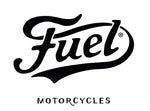Crush the IG game: how to take the best photos with your bike

I'm Arnau Puig, a photographer from Barcelona. I started in the world of photographic productions as a young man helping different photographers. At the same time, thanks to my family's passion for motorsports, I went to take pictures at car rallies, which allowed me to improve and practice different techniques.

I have been working professionally in photography since I was 21 years old. I am currently working on content creation, advertising, and publishing for brands and magazines in the motor world. I am always motivated to explore different techniques and accept new challenges. In recent years, my work has led me to do photoshoots in Europe, Africa, and the USA. I like to combine action photography with lifestyle when it comes to work.
I met the Fuel team because when I was working for a motorcycle magazine, I had to do a photoshoot of a BMW R NineT Racer and was looking for a motorcycle workshop as a location. A friend told me about Fuel, and we were able to do the session in their workshop, which fit perfectly for the photos I wanted to take. Since that shoot, we've been in touch to work together.
FIND THE BEST AREA TO TAKE A PHOTO
The best area to take the photo is mainly a place where the driver can conduct the action or stand for a still photo, and the photographer has a minimum of space to move.
We need to identify the background where we want to shoot and see how the light reaches in that direction. If we look for a contrasting photo, we will try to have the sun at 3/4 of the subject so that the sun will illuminate one part and the other will be shaded. If there is full backlight, the contours will be more outlined between the light and shaded areas. Besides, if it's a cloudy day, or it is a shady spot, such as in the middle of a forest or an urban area with buildings very close together, the photo will be more homogeneous in terms of lighting.
Sometimes it is better to look for a place such as a straight line, where we can play with the depth, the trail of dust that lifts the bike, or just do side sweeps; a smooth curve where it is easy to do an action and repeat it several times is a good place to skid, for example, and allows you to optimize the framing and position of the pilot. Taking photos in the most technical and difficult place does not necessarily mean it is the best place to shoot.
It should be noted that it should not always be a close-up of the bike or rider; giving importance to landscapes even if the subject is smaller can give very good results.
If you already know the area where you are going to take photos that’s perfect, but if not, the street view of Google Maps and apps that give you the position of the sun are always good allies to find great locations, get an idea of what they will be like, and see the light there will be at different moments of the day.

Sliding in a smooth curve. 300mm ISO:160 f/6.3 1/400

Static with backlight. 33mm ISO: 500 f / 5.6 1/400

Landscape action. 300mm ISO: 320 f / 6.3 1/640
HOW TO TAKE MOVING PHOTOS - SWEEP VS FROZEN
The sweep option seeks to give maximum dynamism to an image in which the subject (or part of it) is sharp and the rest in motion. The lower the shutter speed we use, the more moving the background of the image will be, and, therefore, it will transmit more sensation of speed.
The best thing to do to make a sweep is to focus on the subject and follow the movement with the camera in continuous focus mode (Al Servo). This way, the camera will focus on the subject at all times.
Another way to do this is that if you know exactly where the subject will move, you can approach this point manually and shoot when the subject passes.
Whether using Al Servo or manual focus, burst mode will help us have more well-focused photos, as the slow shutter speed makes it harder to focus sharply on the subject doing the action.
To take a frozen photo, you have to shoot at a high shutter speed (1/500, 1/1000, 1/2000, etc.); although it will depend on the subject's movement, the faster you go, the more we will have to increase the shutter speed to freeze the motion. A frozen image stops the moment of the action we want; it can be used, for example, to see all the dust in detail that comes out of a skid, freeze a jump, or capture the drops of water that come out when the subject passes through a puddle.

Static jump 300mm ISO:100 f/5 1/1000

Frozen skid. 200mm ISO:320 f/5.6 1/1000

Swept. 263mm ISO:100 f/8 1/60
PHOTO TIMING
The timing of taking the photo is one of the most critical points in photography. A place can change radically depending on the time of day and the sun's position.
I find it essential to play with the backlights during the first and last hour of the day (golden hour). The outlines, shadows, and volumes that mark the backlight of these hours of the day help to take interesting photos, even the places that seem the most simple at first glance, such as an open field or an esplanade. That's not to say that the rest of the day in terms of light doesn't work for photos. Depending on the location, you need the light to be as high as midday light, which, although more challenging, will illuminate for example between buildings or under a bridge because the light passes in between. Another interesting time of the day, which is very short, is before sunrise or just after sunset, that blue hour when the light is very soft.

Backlight during the last hour of the day

Static blue hour, just after sunset

Sweep at noon approx. 1 p.m.
HOW TO TAKE PHOTOS ALONE
If you go alone and want to take pictures, it always helps to carry a small tripod, but if you don't have one, you can always find stones or branches to fix the camera or directly place the camera on the ground.
If your idea is to take a still photo on or next to the bike, you should first place the bike where you want to take the photo and focus. Because after pressing the trigger in countdown mode, you will be in the same place as the bike, and you will also be well focused.
If, on the other hand, you only want yourself to appear in the photo or the bike is in the background, a simple way to put the focus is by placing an element where you want your position to be, focusing it before pressing the shutter button, putting the lens in manual focus and then set yourself where the item in question is.
Depending on the camera you use, there are apps available you can use to see what the camera sees through your mobile phone, change all photo modes, and shoot.

Camera on the ground. 148mm ISO: 50 f / 5 1/250

Ground camera + backlit flash. 50mm ISO: 250 f / 1.6 1/1000

Elevated camera, motorcycle out of focus. 50mm ISO: 100 f / 2.2 1/1000
TYPES OF PHOTOS TO SHOOT IN A BURST
One of the main benefits of bursting is catching almost every moment of action and choosing the best photo. It is not necessary to use the burst for all action shots, but since a motorcycle is moving fast, in many cases, it will help us have the whole action photographed. When we do action shots at low speed, shooting in a burst, you can have more images that are well focused.
To take action shots, set the burst mode and follow the bike with the AI Servo focus option; this will make the camera continuously focus wherever the focus point is. Another way would be to put the manual focus in the direction of the action.

Selected photo of a burst. 24mm ISO: 320 f / 7.1 1/400

Selected burst sweep. 176mm ISO: 250 f / 10 1/50
BEST MOTORCYCLE POSITIONS
The best positions for taking action photos of a person riding a motorcycle are very subjective and depend a lot on the style of the bike and the discipline that is practiced. For example, in the case of Enduro or MX, it is better to look for a more aggressive and dynamic position, even if the rider is not going very fast. If it's a road bike, you can look for a more relaxed style.
As for static photos, there are a thousand possibilities; some ideas you can play with are to lean on different parts of the bike (seat, handlebars, around the bike), look at the camera or towards the horizon, or show you wearing the equipment (gloves, goggles, helmet).
Obviously, there are no set rules in this regard; feel free to try and see how you like it best. Here are some examples of action and static.



PRESETS / HOW TO EDIT PHOTOS
My personal workflow is always taking the photos in RAW and editing light and color with Capture One; if I have to modify or remove any element in the image after this, I use Photoshop. As for presets, I don't use purchased or downloaded ones; throughout my career, I've been creating my own presets in the editing program and use and modify them based on each session. However, if you start from scratch in a program, you can always download or buy pre-made presets, although I recommend that once applied, you can modify it to fit the photo.

Photo editing is a very broad and subjective topic; everyone has their own personal editing style. Depending on the type of photo, you may want to look for one final style of the image or another, so the same preset will not always work for various images, such as an image in full sun in the desert and another in a rainforest.
In my case, in general terms, when it comes to photos of desert environments, to intensify this environment, I bring the image to warmer and golden tones and desaturate very vivid tones such as the blue of the sky, bringing it slightly closer to cyan. In an atmosphere of forest and rain or clouds, for the photo to have a more dramatic tone, I bring all the colors to grays and highlights and shadows to more greenish and bluish tones. To give more importance to the subject, it is good to use vignette, either automatic or with gradients, to have more control over the editing.











